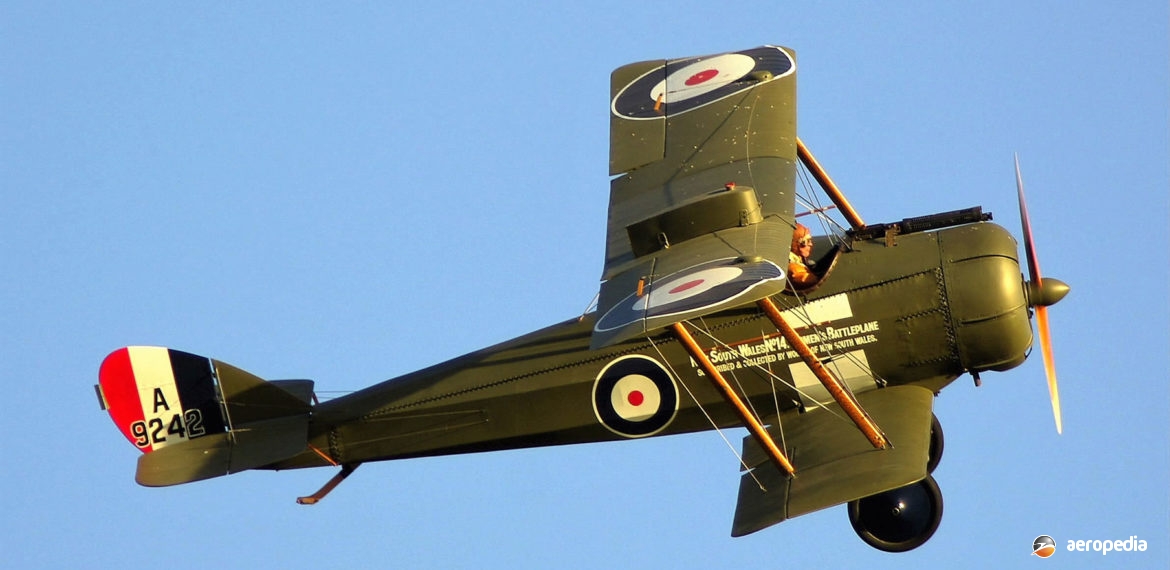Photograph:
de Havilland DH.5 replica ZK-JOQ / A9242 (c/n A9507) at Masterton, NZ in April 2012 (David C Eyre)
Country of origin:
United Kingdom
Description:
Fighter-scout and reconnaissance biplane
Power Plant:
One 82 kw (110 hp) Le Rhone 9J nine-cylinder rotary piston engine
Specifications:
- Wingspan [upper and lower mainplanes]: 7.82 m (25 ft 8 in)
- Length: 6.71 m (22 ft)
- Height: 2.78 m (9 ft 1½ in)
- Wing area: 19.7 m² (212.1 sq ft)
- Max speed at 3,048 m (10,000 ft): 164 km/h (102 mph)
- Max speed at 4,572 m (15,000 ft): 143 km/h (89 mph)
- Landing speed: 80 km/h (50 mph)
- Climb to 1,980 m (6,500 ft): 6 mins 55 secs
- Climb to 4,572 m (15,000 ft): 27 mins 30 secs
- Service ceiling: 5,182 m (17,000 ft)
- Endurance: 2 hrs 45 mins
- Range: 322 km (200 miles)
- Fuel capacity: 118 litres (26 Imp gals)
- Empty weight: 458 kg (1,010 lb)
- Military load: 118 kg (260 lb)
- Loaded weight: 677 kg (1,492 lb)
Armament:
One 7.7 mm (0.303 in) Vickers machine-gun firing forward; provision for up to four 11.3 kg (25 lb) bombs on underwing racks
History:
In June 1914 Geoffrey de Havilland moved from the Royal Aircraft Factory to the Aircraft Manufacturing Company Ltd (Airco) and commenced design of a series of reconnaissance and scout aircraft, the first becoming the Airco DH.1, followed by the DH.2. The Airco DH.5 was designed in 1916 as a replacement for the single-seat DH.2, which had a pusher engine behind the cockpit, this type of design being used to allow for the installation of a fixed forward-firing machine-gun. Construction was conventional for the time, being wood with fabric covering.
However, following the design and development of the Constantinesco interrupter gear, the DH.5 with a tractor configuration promised superior performance and was immediately placed in production. The design featured considerable backward stagger of the biplane wings so the pilot could be seated forward of the leading-edge of the upper wing, thus providing better visibility. The prototype (A5172) underwent official trials in December 1916 in the hands of B C Hucks at Hendon in Greater London and later was taken to France for trials.
In May 1917 the type entered service with Nos 24 and 32 Squadrons of the Royal Flying Corps (RFC), later being operated by Nos 41, 64 and 68 Squadrons, the latter becoming No 2 Squadron, Australian Flying Corps (AFC). However, its handling characteristics and performance at altitude were not the equal of other types then in or entering service and, after suffering badly at the hands of enemy units, it was relegated to the ground attack role where its structural strength and good forward visibility made it an ideal aircraft in this role. It was replaced in service by the RAF SE.5a in 1918. The Royal Flying Corps became the Royal Air Force on 1 April 1918.
In 1917 British forces attacked the German Army on the Hindenburg line and No 2 Squadron AFC supported the operation strafing targets on the ground and dropping bombs. Aeroplanes involved included A9473 flown by Capt J Bell, A9461 flown by Lt F G Huxley, and A9275 flown by Lt Leslie Hubert Holden. A9473 was seriously damaged by ground fire and Capt Bell was wounded, later succumbing to his wounds. A9378 of Lt H Taylor crashed behind enemy lines and was recovered by British forces.
Of the 18 aeroplanes involved, seven were shot down. During the continuing battle, on 22 November Lt Huxley in A9461 shot down an Albatros near Raillencourt, and on 6 December shot down two DFWs. Subsequently the unit was withdrawn and re-equipped with RAF SE.5as. Following the Battle of Cambrai in November 1917 Capt G C Wilson in A9449 was awarded a Military Cross (MC).
In all some 550 DH.5s were built, 200 by Airco, and the others by British Caudron Company Ltd (50), Darracq Motor Engineering Company (200) and March, Jones & Cribb Ltd (100). One example was fitted with a 82 kw (110 hp) Clerget rotary engine, and another with a 75 kw (100 hp) Gnome Monosoupape for trials.
Examples known to be flown by pilots of the Australian Flying Corps with No 2 Squadron in 1917 included A9197 by Lt H Taylor and Lt S K Muir; A9288 by Capt R C Phillipps; A9344 by Lt Leslie H Holden; A9424 by Lt S W Ayers; A9449 by Capt G C Wilson; and A9544 by Lt R W Mckenzie.
A number were bought as presentation aircraft by the public, these including A9415 and A9432 by the NSW Government; A9242 by ‘the Women of NSW and Others’ painted as ‘The Women’s Battleplane’; and A9245 by the Upper Hunter District, NSW painted as ‘The Upper Hunter Battleplane’.
No examples made it to this part of the world and the type is extinct. However, in 2002 a replica was imported to Omaka, Blenheim, on the south island of New Zealand, to join a collection of World War I replica aircraft with The Vintage Aviator Limited (TVAL). This machine was built in the United States by John Shively during the 1980s, had a steel tube construction fuselage with fabric covering, and was powered by a Lycoming O-320 four-cylinder air-cooled engine.
The replica DH.5 spent some time flying in the United Kingdom on air show work before returning to the United States, being acquired by TVAL from the Ryder Collection at Guntersville, Alabama in 2003, being airworthy when obtained. It underwent some refurbishment, becoming ZK-JOQ / A9507 (c/n A9507 – ex N950JS) with the Aviation Heritage Collection at Blenheim, painted as presentation aircraft ‘Women of NSW No 14 Battleplane’ and ‘Subscribed and collected by Women of New South Wales’.

